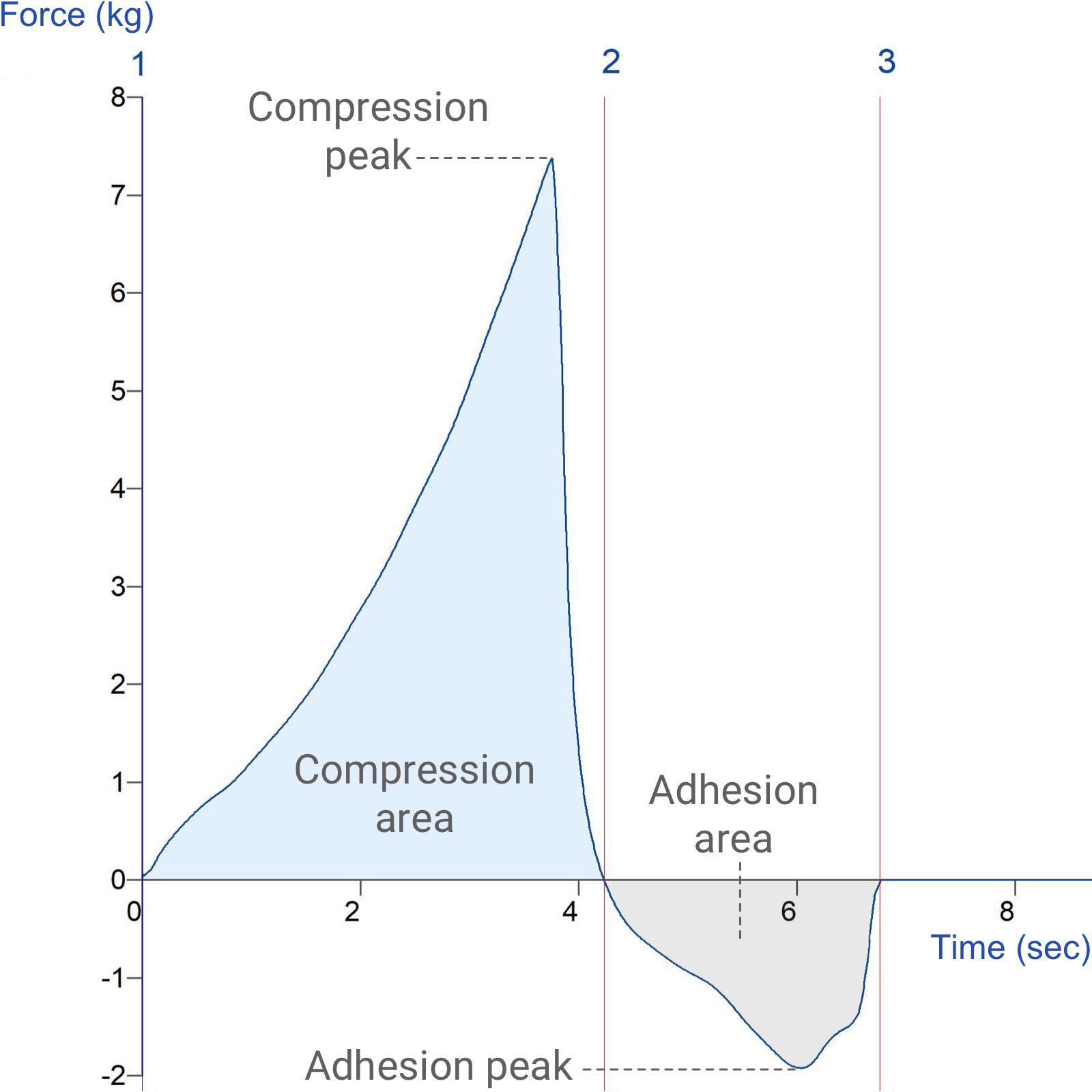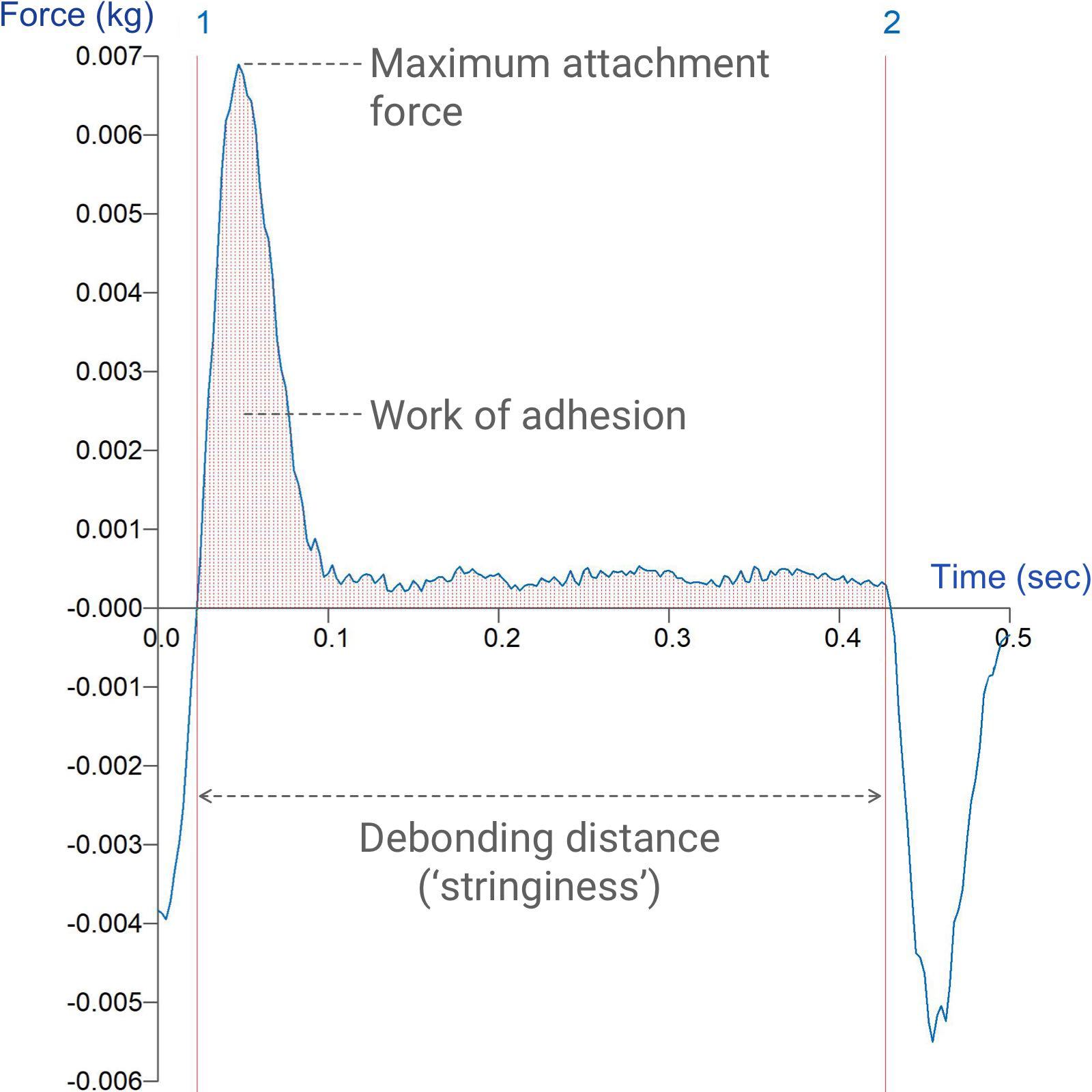How to measure stickiness / adhesiveness

Stickiness/adhesiveness: definition and importance
Stickiness/adhesiveness refers to the force required to overcome the attractive forces between two surfaces in contact. It is a desirable characteristic in certain applications, such as adhesives, medical tapes, and coatings, but can be undesirable in industries like food processing, where excessive stickiness can cause production inefficiencies.
Tackiness, a related term, describes the cohesive and sticky properties of materials. Understanding stickiness is essential for ensuring product functionality, quality, and user experience across multiple industries.
Further example applications of stickiness/adhesiveness testing
Stickiness or adhesiveness testing using a Texture Analyser provides critical insights into the adhesive properties of various products and materials, ensuring optimal performance and quality control. Below are key applications:
- Food adhesive force testing: Measuring the stickiness of food products like cheese, dough, caramel or chocolate by assessing the force required to separate adhered food pieces. This may be desirable/undesirable depending upon the food and the consumer’s expectations. Highly sticky doughs are harder to handle, causing issues during production, whereas doughs with the right level of stickiness offer better control and ease of shaping. Products like caramel, nougat, and sticky toffee require careful monitoring of adhesiveness to ensure they do not become too difficult to package or consume. Stickiness is also important for spreads like peanut butter, honey, and jams. Excessive stickiness can make these products harder to use, as they adhere too much to utensils or packaging.
- Packaging material adhesive strength analysis: Evaluating the adhesive strength of packaging materials, such as tapes or labels, by measuring the force needed to peel them from substrates. In packaging, the stickiness of seals and closures determines how effectively they maintain the integrity of the package.
- Pharmaceutical tablet adhesion testing: Testing the adhesion of pharmaceutical tablets to ensure they do not stick together during production by measuring the force required to separate adhered tablets.
- Adhesive bond strength evaluation: The adhesive properties of tapes and labels are crucial for ensuring they stick properly to surfaces but can also be easily removed without leaving residue. Measuring the adhesiveness of adhesives helps optimise their bonding strength for specific applications.
- Cosmetic product adhesion analysis: Evaluating the adhesiveness of cosmetic items like powders and creams by measuring the force needed to remove a finger or cosmetic applicator from the product. Consumers expect these products to spread easily on the skin without leaving a sticky residue. Measuring adhesiveness helps optimise product formulations for better sensory properties.
- Textile material adhesion testing: Testing the adhesion of textile materials, such as hook-and-loop fasteners, by measuring the force required to separate adhered fabric pieces.
- Medical device adhesive force measurement: Measuring the adhesive strength of medical devices like wound dressings and patches by assessing the force needed to peel them from the skin to ensure proper adhesion for drug delivery systems. Products that are too sticky may be uncomfortable to apply or remove, while those that do not adhere enough may not stay in place long enough for effective drug delivery.
- Tape adhesiveness evaluation: Evaluating the stickiness of adhesive tapes used in construction by measuring the force required to peel the tape from a surface.
- Printing ink adhesion testing: Testing the adhesion of printing inks to substrates like paper by measuring the force required to peel off printed labels or graphics.
- Adhesive film strength analysis: Assessing the strength of adhesive films used in manufacturing by measuring the force needed to separate the layers of an adhesive film.
In these examples, a Texture Analyser applies controlled forces/distances to measure the stickiness or adhesiveness of products, providing essential data for product development, quality control, and performance.
Typical probe/attachment used for measurement
All sizes of Cylinder Probes, Hemispherical and Spherical Probes
In a typical stickiness/adhesiveness measurement test, a probe is pressed onto/into the sample and then withdrawn. The force required to detach the probe from the sample is recorded.
Compression/penetration test (Basic Return to Start test)
Adhesive test
Avery Adhesive test using a 1" Spherical Probe
The success of stickiness/adhesiveness measurement relies of the sample being held down in order that the probe/attachment can be separated from the sample. Specialist attachments such as the Tablet Coating Adhesion Rig, the Confectionery Holder, the Flexible Substrate Clamp, the Warburtons Dough Stickiness System, the Mini Stickiness System, the Mucoadhesion Test Rig and the Pasta Firmness/Stickiness Rig have all been designed with the purpose of holding down the sample in order to perform the stickiness test successfully.
The Adhesive Indexing System, 180 Degree Peel Rig, and Universal Peel Rig have all been designed to measure peel adhesion properties.
Typical graphs
Compression/penetration test (Basic Return to Start test)
Adhesive test
How to interpret the Texture Analyser graph
Two main techniques are used to measure stickiness and adhesiveness:
Compression/penetration test (Basic Return to Start test)
In this test, a probe compresses/penetrates the material, allowing the material to adhere to the surface of the probe. The force required to separate the probe from the material is observed in the negative region of the curve upon probe return to its starting position. This method provides a measurement of both firmness and adhesive forces but is based on applying the probe/attachment to a distance before its return.
 Typical curve indicating key analysis points of a compression/penetration stickiness test
Typical curve indicating key analysis points of a compression/penetration stickiness test
From the graph you can observe/obtain the following:
- 'Quick Stick'
- Surface stickiness and stringiness
- Work of adhesion
- Energy of adhesion
- Stickiness/adhesiveness
- Cohesiveness
- Mucoadhesion
Adhesive test
This test allows the choice of an applied force of the probe to the material. This provides a high degree of repeatability of the contact between the probe and material surface and allows a hold time to be chosen to achieve a good bond between the two surfaces before the probe/attachment is withdrawn. This test present adhesive properties in the positive region of the curve.
 Typical curve indicating key analysis points of an adhesive test
Typical curve indicating key analysis points of an adhesive test
A full explanation of these curves and their analysis can be accessed within Exponent Connect software. Existing Exponent users can upgrade to Exponent Connect specification
Below is a video example of how we can help you understand curve analysis for an example property.
Key factors affecting stickiness/adhesiveness measurement
- Temperature: Temperature significantly influences stickiness measurements, as it affects the viscosity and surface properties of materials, often making them more adhesive at higher temperatures.
- Test speed: The rate at which adhesive force is applied or measured can influence the results, as some materials may exhibit different adhesive behaviours at varying speeds.
- Contact time: The duration of contact between the adhesive material and the surface it's sticking to can affect the strength of adhesion, with longer contact times often resulting in stronger bonds.
- Applied force: The initial force used to bring the adhesive material in contact with a surface can impact the measured stickiness by affecting the area and strength of contact.
- Environmental humidity: Ambient humidity levels can alter the moisture content of samples and affect surface interactions, influencing stickiness measurements.
- Sample preparation: Consistent and appropriate preparation methods are crucial for accurate stickiness measurements, as variations in preparation can lead to inconsistent results.
- Probe material and geometry: The material and shape of the probe used in testing can significantly impact how it interacts with the sample, affecting the measured adhesive force. The choice of probe material and surface energy needs to be considered. Surface energyrefers to how readily a material interacts with a surface. Materials with high surface energy tend to exhibit stronger adhesive forces. This is particularly important in packaging and adhesives, where the interaction between the material and the surface determines the strength of the bond. You should also consider whether the test is looking to mimic the interaction of a certain material with a sample e.g. measuring the adhesion of dough to rollers.
- Surface texture: Rough or porous surfaces may affect adhesion.
- Moisture content: Higher moisture content increases stickiness in many materials, particularly in foods like doughs or sticky candies. Water enhances the material’s ability to bond to surfaces by increasing the number of interactions between the material and the contact surface. Conversely, drier materials generally show less stickiness.
Optimising stickiness/adhesiveness measurement and analysis: The Stable Micro Systems advantage
The Stable Micro Systems Texture Analyser stands out in optimising stickiness and adhesiveness measurements through its comprehensive approach and specialised features. Accurate measurement of stickiness/adhesiveness requires precise collection of events that occur quickly.
Exponent Connect software enhances accuracy by capturing data at 2000 points per second, providing highly detailed graphs for in-depth analysis. In contrast, lower data collection rates, often found in alternative equipment, can result in compromised accuracy and missed information, impacting the reliability of the results.
Exponent Connect software features a unique Adhesive Test sequence which allows a chosen force to be applied to the sample for repeatable preparation of the bond between the probe and sample which can be held for a chosen time before withdrawing to a chosen height during the debonding stage. It accurately quantifies multiple properties including work of adhesion, adhesiveness, cohesiveness, and stringiness, providing a holistic view of a product's adhesive characteristics.
Equipped with dedicated tools like the Tablet Coating Adhesion Rig and Mucoadhesion Test Rig, it precisely measures stickiness across a wide range of products from confectionery to pharmaceutical patches. The Texture Analyser captures detailed force-time-distance profiles for industry standard methods such as ASTM, ISO, and FINAT, which are built into the Exponent Connect software.
Backed by Stable Micro Systems' expertise in graphical interpretation and method development, makes the Texture Analyser the ideal choice for researchers and manufacturers seeking to refine product formulations and maintain quality standards in stickiness and adhesiveness testing across various industries.
A choice of specially designed test adhesion measuring attachments with industry standard compliance.
Built in ASTM, ISO and FINAT standards with comprehensive analysis of graph features obtaining multiple parameters.
Ability to additionally capture synchronised video for fast occurring events and better understanding of product behaviour.
A unique adhesive test sequence for precise sample preparation with high data acquisition rate at micro-level accuracy in force and distance.
If you need help with your stickiness / adhesiveness measurement, we offer unrivalled support.
We can walk you through the steps to successful testing and analysis of stickiness and adhesiveness.









